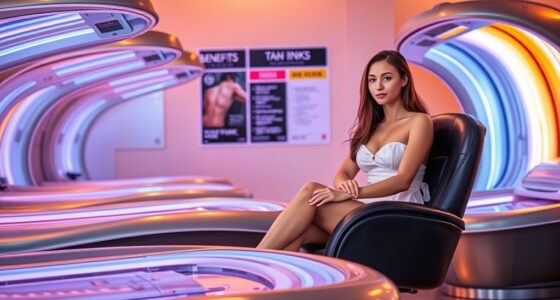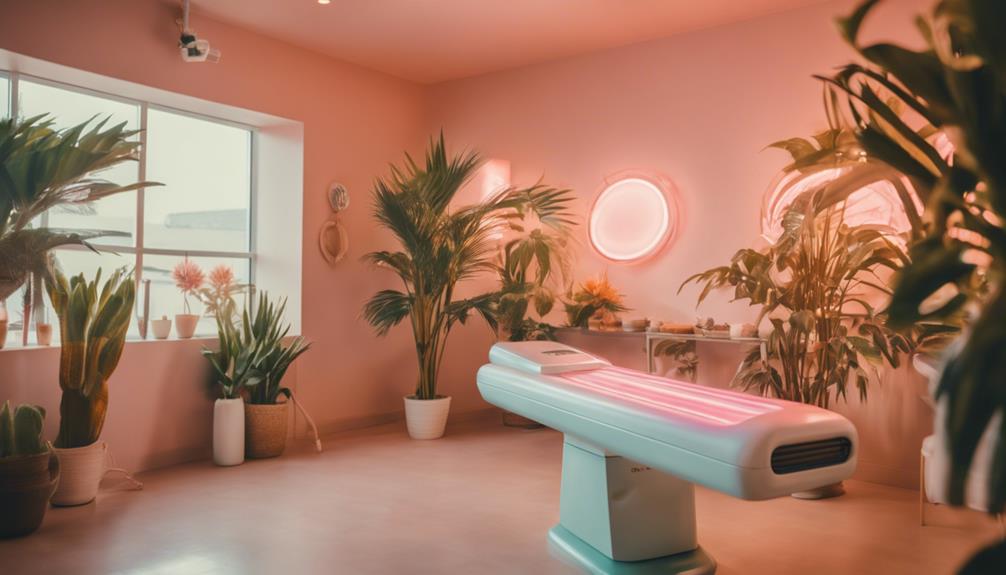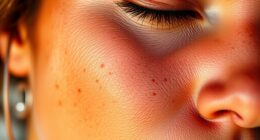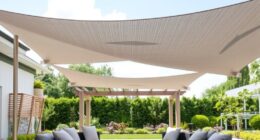Using sunbeds as an older adult can be risky, as they emit concentrated UV rays that speed up skin aging and increase your chances of skin cancer. Many believe sunbeds are a safe alternative to natural sunlight, but they actually cause irreversible damage, like wrinkles, spots, and rough skin. Relying on them for vitamin D or mood boosts isn’t safe either. To protect your health and youthful appearance, it’s important to understand these risks and explore safer options.
Key Takeaways
- UV rays from sunbeds damage skin’s collagen, accelerating aging, wrinkles, and sagging in older adults.
- Many believe sunbeds are safe, but they emit concentrated UV radiation that increases skin cancer risk.
- Relying on sunbeds for vitamin D or mood enhancement poses health hazards; safer options exist.
- Cumulative UV exposure leads to irreversible skin damage, uneven pigmentation, and higher skin cancer risk over time.
- Avoid indoor tanning; opt for diet, supplements, or medical guidance for vitamin D and skin health preservation.

As sunbed use becomes more popular among older adults, it’s important to understand the potential health risks and benefits associated with this practice. One of the main concerns with using sunbeds is UV exposure, which can considerably impact your skin’s health. While some believe that controlled UV exposure from sunbeds might help improve mood or boost vitamin D levels, it’s essential to recognize that intense or frequent exposure can accelerate skin aging. UV rays penetrate the skin and damage collagen and elastin fibers, leading to wrinkles, fine lines, and sagging skin over time. This process, known as photoaging, can make you look older than your actual age and contribute to skin discoloration or age spots.
Many older adults are under the misconception that sunbeds are a safe alternative to natural sunlight, but this isn’t the case. Unlike natural sunlight, which varies in intensity and spectrum, indoor tanning devices emit concentrated UV radiation that can be more damaging. Over time, this exposure can cause irreversible skin changes, making your skin appear aged prematurely. You might notice increased roughness, uneven pigmentation, or a leathery texture that’s difficult to reverse. These effects not only affect your appearance but also increase your risk of developing skin cancers, including melanoma, basal cell carcinoma, and squamous cell carcinoma.
It’s understandable to seek ways to feel better or improve your health, but relying on sunbeds for vitamin D synthesis isn’t advisable due to the risks involved. You can achieve adequate vitamin D levels through diet and supplements without exposing yourself to harmful UV rays. If you’re considering sunbed use to combat feelings of low energy or depression, consult a healthcare professional for safer options. Remember, the quick fix of a tan isn’t worth the long-term consequences to your skin’s health and appearance.
Being informed means you can make smarter choices. While UV exposure in moderation might seem harmless, the cumulative effect over years can lead to notable skin aging and health issues. Protect your skin by avoiding indoor tanning and opting for safer alternatives like vitamin D-rich foods, supplements, or light therapy under medical supervision. Your skin’s health is an essential part of your overall well-being, and understanding the risks helps you preserve your skin’s youth and vitality for years to come. Understanding photoaging is key to making informed decisions about UV exposure.
Frequently Asked Questions
Are There Any Safe Alternatives to Sunbeds for Older Adults?
Yes, there are safe alternatives to sunbeds for older adults. You can explore indoor tanning with UV-free options like spray tans or tanning lotions, which give a natural glow without UV exposure. These methods are safer and help you sidestep the risks associated with indoor tanning and sunbeds. Always consult with a healthcare professional before trying new tanning options to ensure they’re suitable for your skin type and health needs.
How Does Sunbed Use Impact Skin Aging in Seniors?
Did you know that using sunbeds increases your risk of premature aging by up to 20%? When you use sunbeds, UV radiation damages collagen and elastin, leading to decreased skin elasticity. This accelerates wrinkles, sagging, and age spots in seniors. So, if you’re concerned about aging gracefully, avoid sunbeds and protect your skin from UV exposure to maintain a youthful, healthy appearance.
Can Older Adults Develop Skin Cancer From Sunbed Exposure?
Yes, older adults can develop skin cancer from sunbed exposure. UV radiation from tanning beds penetrates deep into your skin, causing damage over time. This skin damage increases the risk of skin cancers like melanoma, basal cell, and squamous cell carcinoma. Even if you’ve used sunbeds before, ongoing use continues to raise your risk, so it’s best to avoid them and protect your skin from unnecessary UV radiation.
What Are the Psychological Effects of Sunbed Use on Seniors?
You may find that using sunbeds boosts your mental health and self-esteem temporarily, giving you a sense of confidence and mood improvement. However, it can also lead to anxiety about skin health or appearance if overdone. The reliance on tanning for feeling better might mask underlying issues like depression or low self-esteem. Remember, focusing on healthier ways to enhance your mental health benefits you more in the long run.
Are There Specific Guidelines for Sunbed Use in Older Populations?
You should follow strict regulatory policies and industry standards when considering sunbed use as an older adult. These guidelines aim to minimize risks like skin damage and skin cancer. It is crucial to consult healthcare professionals before starting, as many regulations advise against or limit sunbed use for seniors. Staying informed about these policies helps ensure safe practices, reducing potential health complications associated with ultraviolet exposure.
Conclusion
As you navigate the world of sunbeds, remember they’re like a double-edged sword—offering a glow but harboring hidden dangers. Older adults need to weigh the fleeting warmth against the long-term risks, especially since misconceptions about safety can cloud judgment. Think of sunbed use as walking a tightrope—you must stay balanced, informed, and cautious. Prioritize your health, and don’t let the allure of a tan overshadow the value of your well-being.








